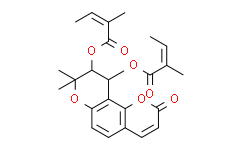| Description: |
Praeruptorin B is an inhibitor of sterol regulatory element-binding proteins (SREBPs). |
| In Vivo: |
The mice treated with Praeruptorin B (50 mg/kg) are significantly lighter than the vehicle treated mice, although they are still heavier than the chow diet-fed mice, suggesting that Praeruptorin B can ameliorate diet-induced obesity (DIO). More importantly, the fat/lean and fat/body-weight ratios are obviously dropped at the same dosage of Praeruptorin B treated mice. It is also showed that the serum TC and TG levels of Praeruptorin B treated mice are significantly lower than those of the HFD-fed mice. Praeruptorin B increases HDL-c and decreases LDL-c similar as lovastatin. In addition, compared with vehicle treated mice, Praeruptorin B significantly lowers the level of TC and TG in liver, comparable to lovastatin. The staining results reveal that Praeruptorin B-treated mice exhibit less lipid accumulation than that of vehicle treated mice. The elevated fasting blood glucose and insulin in HFD-fed mice are significantly reduced by Praeruptorin B[1]. |
| In Vitro: |
Praeruptorin B inhibits the SREBPs activity and decreases intracellular lipid levels. Praeruptorin B is found to powerfully decrease the SRE-luciferase activity, and this effect is dose dependent. Praeruptorin B shows negligible cytotoxicity, even at the higher concentration. Praeruptorin B also significantlytly down-regulates the expression of SREBP-1c and SREBP-2[1]. Praeruptorin B also exhibits significant inhibition on the activity of UGT1A9[2]. |
| Cell Assay: |
HepG2 cells and HL-7702 cells are used in the study. Cell proliferation is determined by the MTT assays. The HepG2 cells are seeded in 96-well plates with 2.0×104 cells per well in DMEM containing 10% FBS for 24 h. Cells are further treated with Praeruptorin B (0, 2.5, 5, 10, 20, 40, 80 μM) for 18 h[1]. |
| Animal Administration: |
Mice[1] Sixweek-old male C57BL/6J mice are housed in colony cages and maintained on a light/dark cycle. On a caloric basis, the HFD contains 60% fat, 20.6% carbohydrate and 19.4% protein, whereas the normal diet contains 13% fat, 60% carbohydrate and 27% protein. The mice are randomly divided into the following four groups (n=6 per group): vehicle-treated chow group, vehicle-treated HFD group, lovastatin-treated HFD group (30 mg per kg per day) and Praeruptorin B-treated HFD group (25 or 50 mg per kg per day). HFD-fed mice are gavaged with Praeruptorin B or lovastatin dissolved in 0.5% CMC-Na for 6 weeks[1]. |
| References: |
[1]. Zu-Guo Zheng, et al. Praeruptorin B improves diet-induced hyperlipidemia and alleviates insulin resistance via regulating SREBP signaling pathway. RSC Adv., 2018, 8, 354–366
[2]. Liu X, et al. The Inhibition of UDP-Glucuronosyltransferase (UGT) Isoforms by Praeruptorin A and B. Phytother Res. 2016 Nov;30(11):1872-1878. |






















